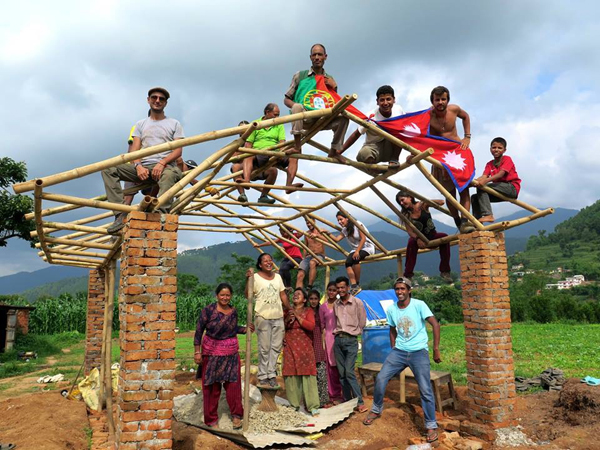
Most of our readers know the world’s forests are being rapidly depleted. Sustainable alternatives are desperately needed. Low cost bamboo is a promising alternative building material because it’s rapidly renewable and widely available. Bamboo is especially well suited for Nepal that is in dire need of scalable solutions that can help rebuild the country. Ms. Neelima Basnet, a Nepali freelance architect, helped implement Joao Boto Caeiro’s bamboo truss method in Chapagaun near Kathmandu. Now there are 22 finished houses.
These $200 bamboo roofs include threaded rod through the center of all short pieces, bolts and cement filled connections. The bamboo is soaked for 15-30 days in the river first then soaked in boric acid solution for 3-5 days in a long trench lined with plastic sheeting. The plastic is folded over the top to keep out rain which would dilute the boric acid. Before soaking, rebar is pounded down the center so the boric acid can penetrate inside. After soaking, threaded rod is inserted through the center of every short piece of bamboo. The roof frame is built on the ground and the whole thing set as one unit on top of posts. These bamboo roofs can be built in two days with a few workers if the bamboo is already treated. The bamboo can be stained any color to be more decorative and durable.
Some critics point out how bamboo is not as durable as other materials. True, this is not a 100-year roof, but right now the overwhelming need in Nepal is immediate shelter, especially with the onset of the monsoon season. The threaded rod makes this design very strong and Neelima believes it is safe for earthquake regions such as Nepal. It is an alternative until people can get enough money to build with timber. She calls it a ‘transitional roof’. Metal roof trusses are too expensive for most and there’s not enough wood to rebuild Nepal, so affordable alternatives such as bamboo are desperately needed.
Joao Boto Caeiro of RootStudio, the original inventor of these bamboo trusses, is a Portuguese architect who offers natural building training in Mexico. This architect has also built larger, more complex shaped trusses for large structures. Here’s his WordPress site: https://berootstudio.wordpress.com/
Neelima knows skilled workers who charge $10/day that can help train other villagers if necessary. The pillars in the video are made with salvaged brick from collapsed houses that are filled with concrete and rebar.
YouTube (bamboo roof segment starts at 6:00)

We toured some of these homes yesterday. They’re in a picturesque mountain area south of Kathmandu. My over all impression is quite favorable. Some of the houses have bamboo and mud plaster walls that look nice. One owner has already added on a bamboo covered porch in back for cooking, etc. The owners seemed very pleased to have houses instead of living in tents or shelters. In general, I see bamboo roofs as one viable option for Nepal. They’re especially well suited for remote villages where wood is not available.